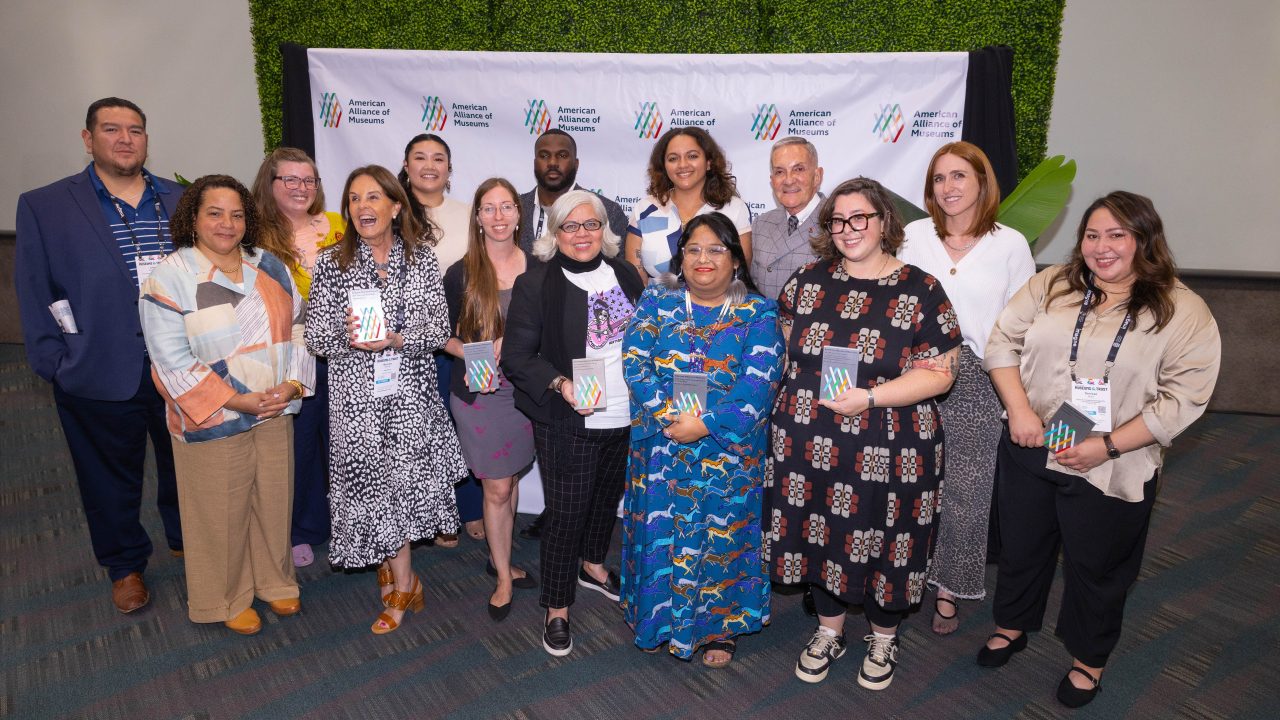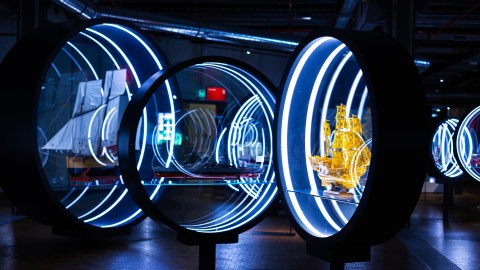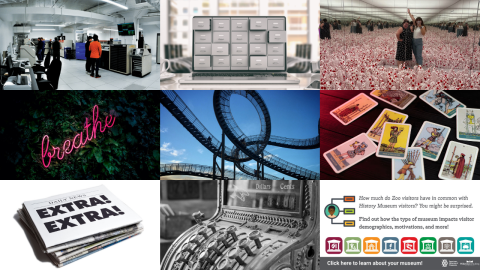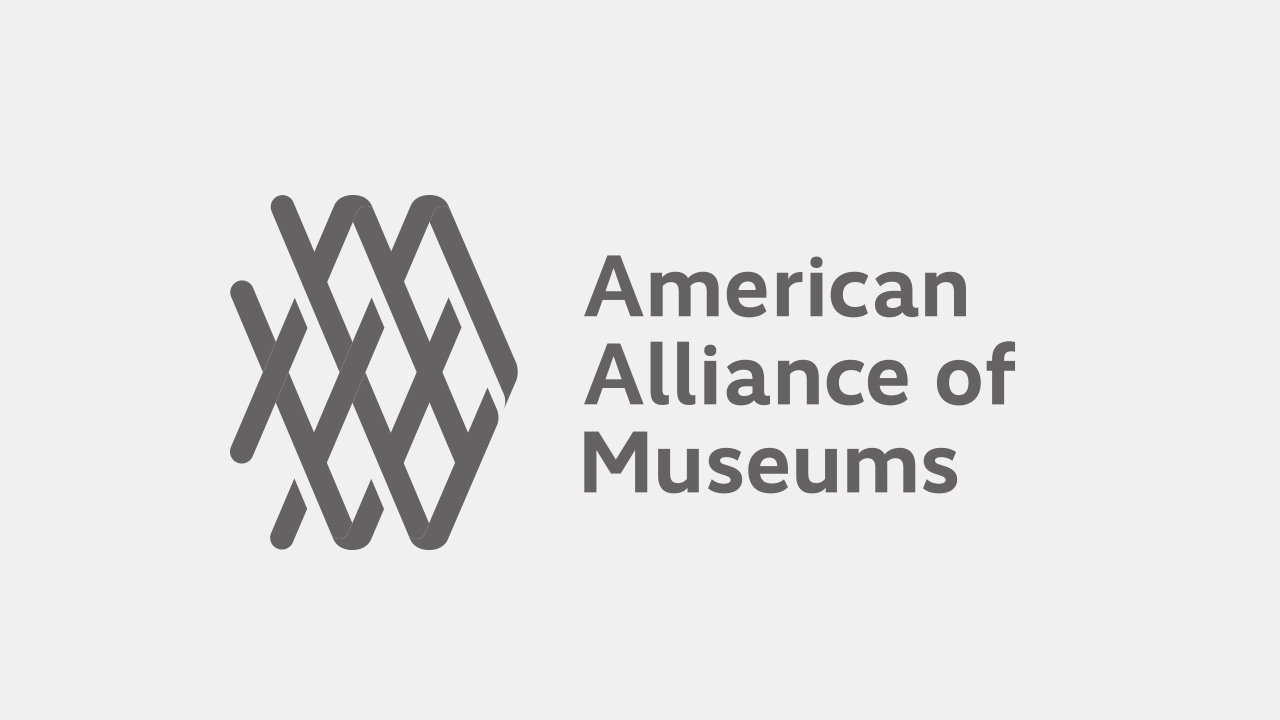
I didn’t always see myself working in museums.
For most of my life, I was immersed in archaeology and the ancient world—focused on digs, research, and physical culture. At the time, I thought museums were places to visit, not places to build a career. What I knew about them came from headlines about provenance scandals and repatriation disputes. I didn’t think they had anything to do with me, until they did.
Everything changed when I left my Egyptology track in graduate school. I realized I didn’t just want to study history. I wanted to help shape how others experience it. Exhibitions and public programs felt more impactful than academic papers oversaturated in complicated jargon.
Letting go of a lifelong dream wasn’t easy. But I knew passion alone couldn’t build the future I wanted. So, I rewrote the plan.
That pivot led me to museums. I’ve now stayed for almost five years, through uncertainty, difficult leadership, and a field that often struggles to support emerging museum professionals (EMP). But I’ve stayed because I still believe in this work. Like many EMPs, I’ve grappled with what it means to love a field that doesn’t always love us back. Over time, I found myself drawn into advocacy—both within and beyond institutions—because we can’t claim to uplift marginalized voices while silencing those who work to amplify them.
That’s why I’m choosing not only to share my story in this post but to amplify the voices of fellow EMPs I’ve met along the way.
One of those colleagues is Chandler Tait, Registrar at the Huntsville Museum of Art, who describes her own motivations for staying in the field this way:
“I often think back to a moment early in my career, when I was able to reframe an artwork by a female, Early Modern artist I greatly admired. I know that specific work has passed through the hands of the artist, the patrons, and a series of registrars before me, all working to keep it safe for future generations. There is always great value in keeping objects safe for those who come after us and playing a role … in the life of an artwork gives me great satisfaction.”
Her words are a powerful reminder that even in the face of uncertainty, there is meaning and legacy in the work we do. Holding space for both passion and frustration has helped me find my footing. Surviving, and thriving, means knowing your limits, speaking up, and remembering that sometimes it’s okay to walk away.
While not a roadmap to success, here are some of the things I’ve learned so far about establishing a museum career.
1. Your Career Path Doesn’t Need to be Linear
I thought I knew how my life would play out, but somehow, I have gone from studying Middle Egyptian hieroglyphs to working in museum administration as a director.
One of the biggest myths in museum work, and the working world in general, is that there’s a single, straight path to success: get the degree, land the entry-level job, climb the ladder. The truth is, most of us take winding routes to get where we are. That’s not a weakness, it’s a strength—and most of the time it has everything to do with the field and little to do with the EMPs within it. The value of formal education is evolving, college programs are reorienting from “book smarts” toward hands-on experience, and employers are signaling that they prefer that. The roadmap that guided generations before us no longer leads to the same destination.
Even if your journey isn’t linear, it helps to have a sense of direction. Ask yourself what kind of work lights you up. Is it education? Collections? Administration? You don’t have to have it all figured out, but defining your interests and values will help you make more intentional decisions about where to spend your energy.
It also makes it easier to explain your choices to potential employers or mentors, especially when your résumé doesn’t follow a traditional path. Clarity doesn’t mean rigidity. It just means you’re steering the ship to safety, no matter the threats on the course.
2. Passion Is the Spark, Not the Strategy
Let’s start this with honesty: We don’t get into museum work because it’s easy. Most of us arrive here fueled by something deeply personal—curiosity, connection, justice, legacy. That kind of passion is powerful; it is the coal in the furnace. It’s the reason we stay late, say yes to unpaid opportunities, and try to improve the field.
As I’ve gotten to know other EMPs across the field, I’ve learned how much joy many of us take in the work, despite the difficult realities of navigating the field. Mackenzie Gardner, Outreach and Education Coordinator at the C.H. Nash Museum at Chucalissa in Memphis, Tennessee, remembers the moment of clarity she felt when she realized she was exactly where she needed to be:
“When I was working in a public library a couple years ago, I started to understand just how many people do not have access to information, let alone higher education. Learning opportunities must be made available to the public, and I knew I needed to help on the ground rather than in a classroom. After I chose to pivot from academia to museum work, I finally felt at home and fulfilled in my career.”
Museum work is more than a job. It is a calling to serve, educate, and expand access. But passion alone won’t pay the bills or protect your peace. To build sustainable careers and stronger institutions, we need more than love for the work: we need strategy.
- Start by knowing your value. Learn about salary benchmarks and show how your skills support the institution’s or the field’s mission. Advocating for fair pay isn’t ungrateful; it’s professional. The “passion tax” is real, especially in smaller museums. Set boundaries, clarify expectations, and push back when roles expand without support or compensation.
- Next, build a peer network. Whether through associations or group chats, connect with others who understand the field from various viewpoints. Mentorship does not have to come from the top. Often, peers a step behind or ahead of you can offer the most practical insight. They know what you’re going through and finding out how they handled similar situations may be of immense help to you.
- Finally, stay strategic. Keep your résumé current, pursue growth opportunities, and track your wins. Know when to grow in place and when to move on. Ask yourself what you’ll need—mentally, financially, and professionally—to stay or leave. That is not pessimism. That is preparation. Passion matters but pairing it with a sustainable plan is what keeps you thriving in this field.
3. Fighting for Museums Means Holding Them Accountable
The field needs you to challenge the status quo. Museums are in a period of reckoning and reinvention, and EMPs play a critical role in that evolution.
Whether it’s rethinking how to tell stories, pushing for more inclusive hiring practices, or questioning outdated policies, your perspective matters. You don’t have to wait until you’re in leadership to speak up. In fact, some of the most important changes come from those who are newer to the field: people who see the gaps, ask bold questions, and aren’t afraid to imagine a better way forward.
Despite being in the museum field for under five years, I have managed to move from entry-level positions to top-level administrative roles. Being newer to the field can offer a distinct advantage: a fresh perspective unshaped by longstanding routines. Emerging professionals often bring curiosity, flexibility, and a willingness to question assumptions, qualities essential for innovation and relevance. While experience brings depth, newer voices can spark necessary change. Rather than seeing limited tenure as a disadvantage, it can be viewed as a strength that allows for clarity and bold thinking. Today’s early-career professionals aren’t just observing the field, we’re preparing to inherit it, and we’re committed to shaping it with purpose, inclusion, and creativity.
So, don’t be silent. Use your voice to advocate for more equitable, accessible, and community-centered museum practices. The museum field will only grow stronger if we make space for new ideas and challenge systems that no longer serve our institutions or our audiences.
Conclusion
Museum work is rarely easy—and it’s even harder when you’re still figuring out where you fit. But if there’s one thing I’ve learned, it’s that our voices, our questions, and our perspectives are not just valid, they’re necessary. The future of museums isn’t just being built in boardrooms or corner offices. It’s being shaped by those of us navigating winding paths, asking hard questions, and refusing to accept “that’s how it’s always been” as a final answer.
Whether you’re just starting out or standing at the crossroads, know this: your nontraditional path is not a liability; it’s your strength. Your passion doesn’t have to come at the expense of your well-being. And your presence in this field is a form of advocacy in itself.
Keep going. Keep asking. Keep building the kind of museums that future professionals and visitors deserve.









Thank you for this reflective post. After a 25-year career in UX design, I’ve started down a new path in museum studies through Harvard Extension School. I’ve only completed one class so far and am gearing up for my second.
Honestly, I have no idea where this road is taking me. I have a strong sense of where I might fit—somewhere at the intersection of tech, design, user experience, and my long-standing passion for the visual arts. But I have no idea if this path makes practical sense, what kind of museum would hire me, or whether I can realistically handle the significant income shift.
Still… I’m here. I’m doing this.
So thank you for your perspective. I really appreciate you sharing how you’ve navigated your career, and especially for your honest depiction of the challenges and realities of surviving (and thriving) as an EMP. It helps more than you know.
Hello Sharon!
I’m so glad that this resonated with you. It just shows that we’re not as alone as we think in the struggle!
In the end, all you can do is ensure that the work you do is fulfilling a need for both you and the people you wish to help. And as someone who wrote her entire thesis on the use of technology, mostly cellphones, in the museum space, I do think there is a place for you in this ever-growing digital world!
The reality of it all is, this work has always been tough, but there has always been an EMP out there who was tougher. That’s how they grow into amazing museum professionals.
Do you have any American examples of the claim that “college programs are reorienting from ‘book smarts’ toward hands-on experience”? I so agree that the path does not have to be linear, but one threat I see to emerging professionals is that many museum studies programs really emphasize the linear career ladder, while simultaneously not preparing students in a hands-on, on the job way. Curious your thoughts on this. Museum studies programs tend to push the idea that the qualification is necessary to make connections/network your way into the field.
Absolutely, I see where you’re coming from.
There are some interesting examples in the U.S. where museum programs are starting to emphasize practical experience alongside traditional coursework. For instance, while writing this article, I saw the following examples:
1) Johns Hopkins University – Museum Studies Program: Their curriculum includes a strong internship component, where students are placed in museums or cultural institutions for hands-on project work, rather than just observation. Johns Hopkins was actually one of my top choice schools when I was still in the world of Egyptology and Archaeology, so I don’t doubt their rigorous standard of quality transfers over to their Museum programs!
2)University of Washington – Museology: This program incorporates practicum experiences as a required element, allowing students to design exhibits, work in collections, or manage public programs.
3) The University of Texas at Austin – Public History/Museum Studies: Their program emphasizes applied experiences through partnerships with local museums, historical societies, and cultural heritage organizations. Students work on real projects, like exhibit development, collections management, or community programming, which gives them hands-on skills and professional connections while still in school.
These programs are just some of the examples of a shifting toward “learning by doing,” reflecting the recognition that emerging professionals need tangible, on-the-job skills to be employable in an increasingly competitive field.
I also agree with your concern about the linear career ladder narrative! Many programs still frame museum work as “intern then assistant then curator” rather than encouraging multiple entry points or entrepreneurial paths in collections, programming, or engagement. This can be misleading, because hands-on experience, especially in areas like social media, event planning, or community engagement, often opens doors faster than strictly following a linear path.
In my view, the key is blending traditional theory with practical application and making sure students understand the real-world skills that employers actually value. It’s not just about qualifications; it’s about producing adaptable professionals who can thrive in diverse roles.
Wonderful article! Last year, I quit my teaching job after developing crippling burnout and depression. This year, I accepted a job at my local museum and am loving it! I’m still in the education field but get to do my job at a pace that suits me. I loved your advice about asking yourself what you need to thrive in a career and I think I’ve finally found it.
Thank you so much for sharing this!
I’m really glad you’ve found a role that lets you work at a pace that suits you and keeps your love of education alive. Burnout is so real, and it takes courage to step away from something that isn’t serving your well-being. Thriving in your career really does come down to knowing what you need, and it sounds like you’ve nailed it!